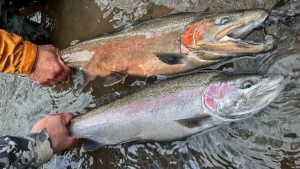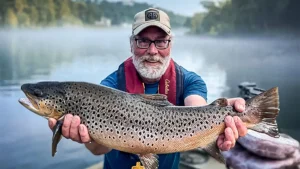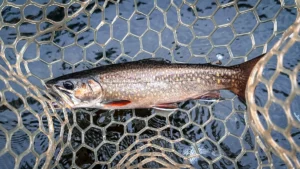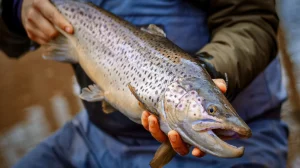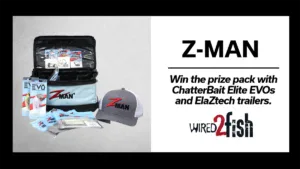Bait finesse system (BFS) fishing has grown globally over the past few years. Anglers of all types have embraced and adapted BFS tackle into their fishing. Like with anything experiencing rapid growth, there will be different interpretations of how people will leverage new and emerging fishing techniques.
Some anglers focus on strictly using BFS tackle as a tool, while most anglers use BFS tackle because it is straight up fun. The internet has exponentially helped with the sharing of ideas and innovation. This guide will focus on selecting tackle specifically for BFS trout fishing as well as strategies for catching trout with BFS tackle.
BFS fishing for trout is really about efficiency and lure control.
ADVANTAGES TO USING BFS FOR TROUT
Accuracy and consistency is a huge reason why I use BFS tackle when trout fishing. The ability to control the trajectory and speed of my lure when casting allows for precise placement of my lure. Using a spinning reel, you are at the mercy of gravity. You cannot easily control the lure’s speed once the cast has begun with a spinning reel.
Something that I think of when I hook into trout, especially in smaller waters, is how the entry of my lure affects the fish I am targeting. In shallow, headwater streams watching a trout attack a lure you placed exactly where you wanted with hardly a ripple on the landing is extremely satisfying. The only thing I can think of that compares is a perfectly delivered dry fly or getting smashed by a bass right after skipping a jig far under a dock. Knowing that same lure with a harder entry into the water would have scared that same fish makes the victory that much sweeter.
BFS fishing brings a new and refreshing experience, even to well-established anglers. Think of it in fly fishing terms. Dry fly anglers will swear by floating flies and never do anything else. Then a streamer angler comes along and asks the fly angler to try it out. Once the dry fly angler feels the connection of ripping a streamer and hooking into a trout, the dry angler cannot deny the experience.
LIMITATIONS TO BFS FOR TROUT
If you prefer to use live bait or any traditional bobber style rigs, casting with BFS tackle can be more trouble than it is worth. Short range casting with steelhead/salmon float rigs does not give the same issues as open water bobber rigs due to the longer rod, weight distribution and shorter casting range.
Always find the limits to any BFS reel in order to ensure you set realistic expectations while fishing.
By far the greatest limitation is the fear of backlashes. Being a baitcasting reel at heart, there is a learning curve to work through before being able to fully extract all the benefits of using BFS gear. If you know how to use a baitcasting reel already, all it takes is a little calibration of your casting motion and you will be good to go. Regardless of your baitcasting skill level, the biggest barrier to anglers is usually being overly optimistic with the capabilities of using BFS gear. Practice with slightly heavier weight than you plan to use. Also, if you are digging in the bottom of your tackle box for flies or extreme micro jigs after your first few casts with BFS gear, you will be terribly disappointed after the inevitable mega backlash.
BAIT FINESSE RODS FOR TROUT
Trout fishing with BFS gear involves specialized rods that cater to the unique demands of this fishing technique. Typically, these rods are short, ranging from 4 feet 6 inches to 5 feet 6 inches, emphasizing precision and control, especially in stream fishing scenarios. While the spotlight often falls on BFS reels, the significance of the rod in achieving optimal casting performance I feel is more important than the reel for BFS trout fishing.
Loading a rod casting in open water is much easier and carefree than doing so in a short range casting situation. Given that the flight time of your lure is shorter when stream fishing, there is less time for the reel’s braking system to react to the rapid changes on speed for shorter casting. Having a rod that loads effortlessly with the lures you plan on casting will make accuracy and presentation much more consistent than force loading the rod. Aim to have the typical lure size you will be using to fall in the middle of the rod’s lure ratings. This will allow the lure to load the rod easily, resulting in less force needed for the cast.
Having your rod load with minimal effort will allow for more consistent casting, especially for short range casting.
Fiberglass is arguably the most common material for BFS trout rods. The supple, flexible nature of fiberglass allows for easy loading of the blank for effortless casting. The durability of fiberglass really shines with the smaller diameter trout blanks.
Most of the cons of fiberglass you would experience with a typical open water rod are reduced with BFS trout rods. The added weight of fiberglass is not enough with the shorter, lighter powered blanks to make a huge difference regarding overall rod weight or balance. In fact, the rod being slightly tip heavy can aid in twitching minnow style lures and make the casting motion smoother.
Fiberglass rods give such a wide range of versatility for BFS trout fishing. With an ultralight rated fiberglass BFS rod, I have effectively targeted trout from 4 inches all the way up to 20+ with the same setup. Versatility is key when discovering new trout waters, as most anglers only carry one rod with them when exploring.
Fiberglass BFS trout rods give so much performance per dollar: (Major Craft Finetail, Dankung Chinese Hooksnout Carp, Palms Egeria Native Performance XXUL).
Carbon/graphite rods are a great choice for anglers who prefer to use small jigs, plastics or other lures where feeling the fish is important. Carbon blanks are generally more crisp and responsive than rods made from fiberglass. Carbon rods are great for twitching minnow style lures and getting solid hooksets when using jigs.
With BFS trout rods being shorter and lighter in power, the sensitivity is often exceptional due to there being less material to absorb vibrations. I find that even with low to mid-grade graphite blanks, carbon BFS trout rods usually feel more sensitive than longer open water rods of a higher quality carbon. The “lower quality” carbon is generally more durable and is slower in action, both great attributes for BFS trout fishing.
As you climb in price, generally what you are paying for is a more complex taper to the blank and some improvements to components. Overall, I feel the taper of high end rods can be cost effective if you plan to only have one BFS trout rod for all of your fishing. The versatility can pay for itself…at least that is what I tell myself.
- Budget: Jackson Trout Signal
- Mid-Level: Jackson Kawasemi Rhapsody
- Enthusiast: Jetstream Tulala Twig
The ferrules of multi-piece rods can really alter the taper of the blank. If the rod blank overlaps itself, it can cause “flat spots” in the taper that affect the overall performance of the rod. The smaller diameter blank shaft that many JDM style ferrules use bend more naturally with the main rod blank. Many rods that use this type of ferrule allow the rod to have a taper similar to using a one-piece blank and add significantly less weight to the blank than overlapping style connections.
Overlapping ferrule (left) negatively affects the rod’s performance far more than JDM style ferrules.
BFS rods with a solid carbon blank act similarly to fiberglass rods with the deeper taper but, with greater, faster recovery like a traditional tubular carbon rod. A drawback to solid carbon rods is the very basic taper many solid carbon BFS rods have. Although the blanks are usually UL or XUL rated, the tapers are still very moderate and the blank can feel overpowered quite easily casting and twitching lures. Being solid carbon, the blanks are pretty tough for a carbon rod and can take quite a beating. My favorite uses for solid carbon BFS trout rods are targeting smaller trout in narrow streams using lures under 3gr.
There are a few other blank materials for rods such as boron, composite and even bamboo! Composite rods are by far the most common of the “other” bunch. Being a blend of fiberglass and carbon, composite rods can be a great option for versatility. Rod manufacturers often list the percentage of carbon/fiberglass of the blank in the rod’s description.
The Daiwa Silver Creek Glass Progressive is a versatile rod that performs great with anything from jigs to minnows.
BAIT FINESSE REELS FOR TROUT
Over my time using BFS gear, one of the most common questions I receive is “what is the best BFS reel?” Well…there isn’t one. Most BFS reels will cast anything from a 1/16-ounce jig up to 3/8-ounce or more (it mostly depends on line capacity at that point). The main factor for me choosing a BFS reel is to make sure the reel can comfortably cast the weight of the lures I plan on using with the reel.
For reference, most trout minnow lures are between 3.5 and 5 grams. A 1/32-ounce jig rigged with a small soft plastic weighs about 2-3 grams, depending on what soft plastic is used. Casting comfortably means not having to put a lot of force into the cast to get the results you are looking for. In stream fishing, you will get the best results by choosing a rod that loads with the weight you are using paired with a reel capable of casting that weight.
Although there are too many to list, here are a few stock options for BFS reels I would choose for stream fishing:
- Budget: iFishband Tendershoot
- Middle: Daiwa Silver Creek AIR TW
- Enthusiast: Shimano Conquest BFS XG

For those on a budget, the iFishband Tendershoot is a reliable option. Although kind of finicky, the basic linear magnetic braking system performs much better than the reel’s price would suggest. Not quite the least expensive BFS reel but, it does perform well enough that beginning BFS anglers will not find themselves “outgrowing” the Tendershoot as their casting skills improve. The 8.1 gear ratio is great for picking up slack line when twitching minnows.
Mid-range, the Daiwa Silver Creek AIR TW is my choice. Although designed for short-range stream fishing, the Silver Creek has a great range of hassle-free casting and performs quite well for long casting as well. The retrieve and drag system are great and the low profile frame fits very well in hand while fishing. Spool options for the Silver Creek AIR TW are abundant as well.
Enthusiasts seeking top-tier performance can opt for the Shimano Conquest BFS XG. Most would say the Conquest BFS is a bit overkill, which I agree. The Conquest BFS is undoubtedly one of the best BFS reels I have used for trout. I am particularly fond of the flat casting trajectory, which reduces wind as a variable as well as allows more consistent casting under overhead cover. Casting is effortless and smooth, retrieve is top notch and who doesn’t love the classy look of a round reel.
AFTERMARKET OPTIONS FOR REELS
Aftermarket spools can be an effective and low risk way to get into BFS fishing. Many companies such as Roro Lure and Avail make BFS spools for mainstream baitcasting reels such as the Daiwa Tatula and Shimano Curado. If you tend to switch frequently between stream fishing and traditional bass fishing, the hassle of constantly swapping spools will push you to getting a deliberate BFS reel to prevent the constant swapping.
Although I enjoy modifying reels and pushing the boundaries of my gear, I find that most BFS reels nowadays are completely capable with the bearings that come from the factory. Aftermarket bearings such as Roro Ceramic Hybrid Micro Bait Finesse Bearings usually give the greatest benefit to casting the tiniest of lures or when slower spool speeds are needed such as fishing narrow creeks with really light lures. A broader application for micro bearings would be pitching micro small bass plastics to targets such as docks or weed edges.
LINE CHOICES FOR BFS TROUT FISHING
In no other style of fishing will the attributes of each type of fishing line contribute to the overall system you create than it does with BFS fishing. The shorter nature of BFS trout rods, while giving the angler great control, also gives the angler far less rod to fight the fish. Having the basic knowledge of fishing line types will allow the angler to adjust their system to yield the greatest results.
Monofilament (known as nylon in Japan) is the safest bet and definitely shines in the close combat ranges common in BFS trout fishing. The stretch of the line will make up for the lack of rod length to cushion the fight and reduce fish escaping due to throwing the light wire hooks used with most finesse lures.
A common thought would be to use clear line to avoid spooking line-shy fish in these finesse fishing situations. I find that the benefit of using a hi-viz line such as VARIVAS Super Trout Advance Sight Edition is much greater than any perceived ill effects of using a bright line.
Trout are known to quickly swipe at and spit lures out. Seeing the exact moment a trout hits your lure will increase your odds of hooking up.
Casting in streams means there is a relatively short time your lure is in the air. That combined with other factors such as small lure size, reduced lighting and shoreline brush means finding and tracking your lure during the cast is much more difficult. Using a hi-viz line will GREATLY increase your casting consistency. The bright line also helps detect what your lure is doing in the water. I have hooked into many fish that I couldn’t feel hit my lure but I saw the line move and knew to set the hook.
If using fast moving trout minnows such as the Jackson Trout Tune, fish that will strike your lure will not be deterred from seeing your fishing line. The only exception I have experienced is if there is A LOT of fishing pressure in the waters you fish, especially if catch and release is common.
Fluorocarbon is the least commonly used line for BFS trout fishing for many reasons. Most importantly, fluorocarbon line commonly has more memory than monofilament and is the most common to backlash with. To add to the potential casting issues, the stiffness of fluorocarbon creates other issues in lighter diameters such as knot strength and lack of stretch.
Fluorocarbon line does offer greater abrasion resistance and sensitivity than monofilament. Those properties, in my experience, have a greater affect while using larger diameter lines. If fishing jigs and soft plastics in slow deep pools, fluorocarbon would seem to provide advantages over other line types. Given the water has current, your line will be easier to keep tight, giving braided line the advantage. I will use a fluorocarbon most times as a leader to braided line to leverage the properties of fluorocarbon.
Stiffer braided lines, such as VARIVAS Super Trout Advance Baitfinesse X4 PE, will give the best results. Limp braided lines work best for spinning gear.
Braided line (known as PE in Japan) gives the angler’s system the most versatility due to its strength, weight and ease of casting. Thin braided lines such as VARIVAS Super Trout Advance Baitfinesse X4 PE add less weight per meter than other line types. The reduced weight can aid with casting small lures with BFS reels. Backlashes are less common and are generally easier to pick out than with monofilament or fluorocarbon lines.
If fishing in climates that experience freezing temperatures, braided line will cause many issues. Due to the strands of braid holding water as the angler reels the lure in, there is much more water that makes its way through the guides and onto the spool compared to monofilament or fluorocarbon. This, when paired with freezing temps, makes fishing come to a standstill. The ice in the guides will make casting lighter lures very difficult and will result in many backlashes.
Tip: If you bought a BFS rod and you feel it is a little too powerful, use monofilament to “soften” the rod. Use braided line to make a rod feel more powerful.
LURES FOR BFS TROUT
Lure choice is often the most overthought part of BFS trout fishing. The fish do not know if it is a BFS setup or a spinning setup delivering the lure. Regardless of any marketing hype, almost any lure, like spinners, can be used with a BFS setup or a spinning setup. The exception would be any disjointed rigs like a split shot rig (think of basic live worm rigging) and other rigs where the casted weight is not at the end of the line.
Although possible with BFS gear, spinning gear hands down wins at casting those rigs.
Trout are predators. Use a variety of lures to see what triggers them into biting. Here are some lures we generally recommend for trout.

Minnow
Minnow-style lures stand out as the most common and versatile choice. These lures can be manipulated to work throughout the entire water column. Their compact and streamline design make them suitable for consistent, accurate casting. Floating, suspending, and sinking minnows each have their place and are effective in targeting specific parts of the water column. To enhance results, anglers can attempt to have their lure deflect off rocks and other structures in the stream to draw reaction strikes. For more information on minnow style lures for trout, I suggest you watch this video on trout minnows to learn how to use all three types of minnow style lures.
Spinner
Most likely the first type of lure you ever had in your tackle box as a kid was a spinner. In-line spinners are seemingly simple lures that straight up catch fish. Many anglers will use braided lines with in-line spinners to reduce the problems with line twist.
Many JDM spinners have carefully thought out weight distribution and other features to help with casting and the dreaded line twist associated with using in-line spinners.
Due to the line reeling straight onto the spool of a BFS reel, any line twist that does happen is not as big of an issue with BFS reels as it is with spinning reels. I still allow my line to “untwist” every few casts after using inline spinners to reduce any issues with my line, especially when using monofilament or fluorocarbon lines.
Jigs and plastics
The meticulous nature of slowly working a small jig is often why they get bit. Imitating nymphs, scuds or minnows, trout cannot resist easy prey that is an easy target. That very reason often traps anglers to overworking a spot or chase a fleeting hope of “there’s gotta be one in that hole” which slows the angler down. If a spot SHOULD be holding fish, use fast moving lures to test the waters and use a jig to get fish to commit who would otherwise swipe at the minnow but swim away. Using a jig as a search tool will slow you down and often catch fish that would have hit any fast moving lure just as easily with less time spent working the lure.
Aggressively twitching a minnow lure allowed me to find this brook trout, a micro jig is what it committed to.
The shape and profile of the soft plastic plays a huge role in lure action. Compact profiles will sink faster and be less affected by the current. Wider profile plastics will fall slowly and drift more with the current. I like using tungsten ice fishing jigs for trout fishing. They come in a variety of sizes and usually go on clearance right before spring trout season starts. Experiment with different soft plastics and jig heads to see what works best for you.
AREAS TO TARGET FOR TROUT
The biggest advantage I can talk about regarding BFS tackle for trout is efficiency. The ability to have quick, one-handed casting will give you many more opportunities to cast to areas that may hold fish. That seemingly small amount of extra time you save by not having to open the bail of a spinning reel, place the line under your finger, cast, then close the bail, adds up over the course of a day fishing. Being able to control the speed of your lure in flight greatly increases accuracy and how softly your lure lands in the water.
I will wade a stream and always have my line in the water. I do not care how shallow or uninhabited the water may look. Too often, we as anglers always look for textbook spots in the stream and then tell ourselves there HAS to be a fish there. The only guarantee I have ever had when it comes to fish location is that the fish are ALWAYS in the water. Of course, be a little more deliberate in those higher percentage areas but never pass water unless you are on a time crunch.
I tend to target areas that other anglers may not want to risk getting snagged. My local waters have a lot of log jams, alder brush and other obstacles all anglers know will hold fish but only a few are daring enough to get close enough. The accuracy of BFS tackle allows the angler to get into those tight areas while the snag resistant lures such as a single hooked minnow greatly increases the chances of your lure getting bit instead of snagged.
FINAL THOUGHTS ON BAIT FINESSE TROUT
Using BFS tackle for trout provides many advantages over spinning gear if using lures, especially as you increase in weight. Spinning gear still provides many advantages when trout fishing over BFS tackle, although that gap is closing as BFS reels are becoming more and more capable. Outside of pure functionality, there is no denying that using a baitcasting reel to cast small lures is downright fun.
Set realistic goals and remember to practice casting. Like with anything in fishing, BFS is merely a tool which the angler can combine with their own skills, knowledge and preferences to have their best time on the water.
















